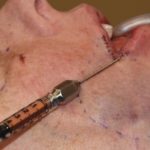The buccal fat pad is a well known reservoir of facial fat that can be removed in selective patients for a cheek thinning effect. The buccal lipectomy is an impressive procedure when one looks at the size of the fat pad as it is being extracted.
But beyond its potential aesthetic facial benefits, the uniqueness of buccal fat is that it is an encapsulated fat collection and it has a large lobules of fat within it. This suggests that this unique collection of facial fat may be metabolically different than other types of face or body fat. The role the buccal fat pad plays has never been precisely defined but it is not one of being a primary depot (collection) site for excess calories. This raises the question of whether buccal fat may offer advantages in fat transfer. (are the fat cells more hardy if transferred?)


The main drawback to the use of buccal fat for fat injections is that the buccal lipectomy procedure must be concurrently done for an aesthetic purpose. Because it creates its own aesthetic effect buccal fat is not harvested only for convenience.
Dr. Barry Eppley
Indianapolis, Indiana


